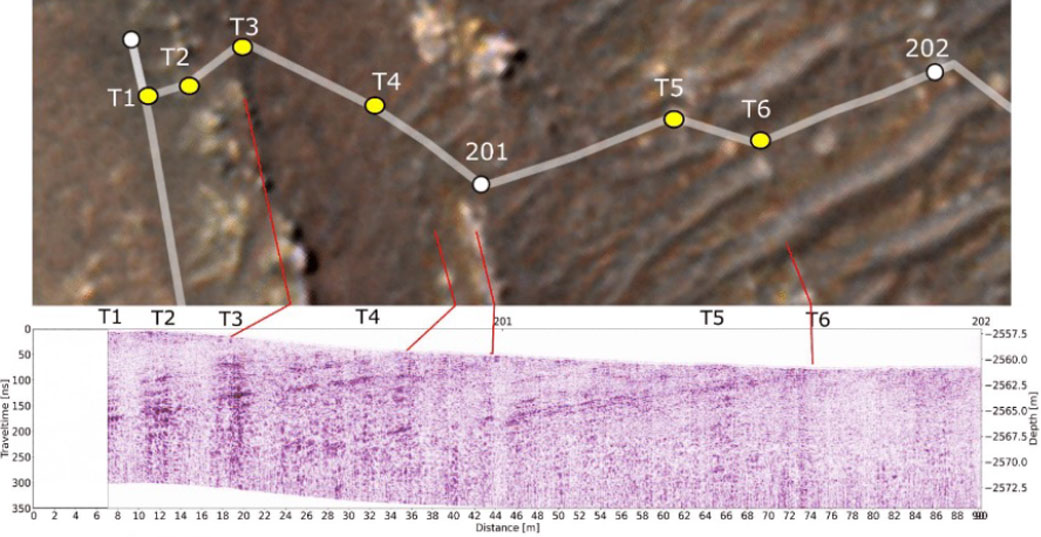NASA's Perseverance rover finds organic chemicals on Mars

NASA's Perseverance Mars rover has found life's building blocks on the Red Planet.
Perseverance has identified carbon-containing organic chemicals in some of the rocks it has examined on the floor of Mars' Jezero Crater, mission team members announced on Wednesday (Dec. 15).
To be clear: This is not a detection of Mars life. Organics can be produced by both biological and non-biological means, and more work is needed to figure out what processes generated the Jezero compounds.
Related: NASA's Perseverance rover mission to Mars in photos
Perseverance won't have to do all that work by itself; the rover is collecting samples that will be hauled to Earth by a joint NASA/European Space Agency campaign, perhaps as early as 2031.
"This is a question that may not be solved until the samples are returned to Earth, but the preservation of organics is very exciting," Luther Beegle, of NASA's Jet Propulsion Laboratory (JPL) in Southern California, said in a statement.
"When these samples are returned to Earth, they will be a source of scientific inquiry and discovery for many years," added Beegle, the principal investigator of Perseverance's SHERLOC ("Scanning Habitable Environments with Raman and Luminescence for Organics and Chemicals") instrument.
Breaking space news, the latest updates on rocket launches, skywatching events and more!
Studying a potentially habitable ancient environment
The car-sized Perseverance landed last February inside the 28-mile-wide (45 kilometers) Jezero, which hosted a big lake and a river delta in the ancient past.
Perseverance has two main mission goals: search for signs of ancient life on Mars and collect the material for humanity's first Mars sample-return effort. Toward this latter end, the rover carries 43 titanium tubes, six of which it has sealed to date. Four of the sealed tubes contain cored rock samples, one has a sample of Martian atmosphere and one harbors "witness" material to help mission team members spot any contaminating compounds that Perseverance may have brought from Earth, JPL officials said in the same statement.
Perseverance spent its first few months on Mars checking out its instruments and systems and supporting the initial pioneering flights of the Ingenuity helicopter, which landed with the rover in February. Perseverance began focusing on its science goals in early June, and it has made quite a bit of progress since then.
There's the organics find, for example, which mission team members unveiled Wednesday at the fall meeting of the American Geophysical Union in New Orleans.
SHERLOC identified organics in the interiors of some rocks that Perseverance abraded with its drill and also in dust on top of some non-abraded rocks, JPL officials said in Wednesday's statement.
"Curiosity also discovered organics at its landing site within Gale Crater," Beegle said, referring to NASA's Curiosity rover, which has been exploring the 96-mile-wide (154 km) Gale since August 2012.
"What SHERLOC adds to the story is its capability to map the spatial distribution of organics inside rocks and relate those organics to minerals found there," he added. "This helps us understand the environment in which the organics formed."
Related: The search for life on Mars (a photo timeline)
Ancient volcanic activity, too
Another Perseverance instrument, PIXL ("Planetary Instrument for X-ray Lithochemistry"), is bringing that ancient environment into clearer focus as well. PIXL analyses of an abraded rock in a patch of Jezero called South Séítah revealed a striking abundance of olivine crystals in conjunction with pyroxene crystals, mission team members announced on Wednesday.
"A good geology student will tell you that such a texture indicates the rock formed when crystals grew and settled in a slowly cooling magma — for example, a thick lava flow, lava lake or magma chamber," Perseverance project scientist Ken Farley, of the California Institute of Technology in Pasadena, said in the same statement.
"The rock was then altered by water several times, making it a treasure trove that will allow future scientists to date events in Jezero, better understand the period in which water was more common on its surface and reveal the early history of the planet," Farley said. "Mars sample return is going to have great stuff to choose from!"
Farley and his colleagues have long wondered whether Jezero's bedrock is volcanic or sedimentary (composed of material deposited by an ancient river, for example). They now appear to have the answer, but there are still more layers to peel back. For example, was the molten rock part of a lava lake on the crater's floor? Or did it form in an underground magma chamber, which erosion has since exposed?
Perseverance could help solve that puzzle and many others over the months and years to come as it continues to take Jezero's measure.
Some of those insights will extend into the Martian underground. Also on Wednesday, the mission team released its first Perseverance "radargram," a snapshot of the subsurface up to 33 feet (10 meters) deep created using data from the rover's ground-penetrating radar instrument.
"The ability to observe geologic features even below the surface adds a new dimension to the team's geologic mapping capabilities at Mars," JPL officials said in the statement.
Mike Wall is the author of "Out There" (Grand Central Publishing, 2018; illustrated by Karl Tate), a book about the search for alien life. Follow him on Twitter @michaeldwall. Follow us on Twitter @Spacedotcom or on Facebook.

Michael Wall is a Senior Space Writer with Space.com and joined the team in 2010. He primarily covers exoplanets, spaceflight and military space, but has been known to dabble in the space art beat. His book about the search for alien life, "Out There," was published on Nov. 13, 2018. Before becoming a science writer, Michael worked as a herpetologist and wildlife biologist. He has a Ph.D. in evolutionary biology from the University of Sydney, Australia, a bachelor's degree from the University of Arizona, and a graduate certificate in science writing from the University of California, Santa Cruz. To find out what his latest project is, you can follow Michael on Twitter.

